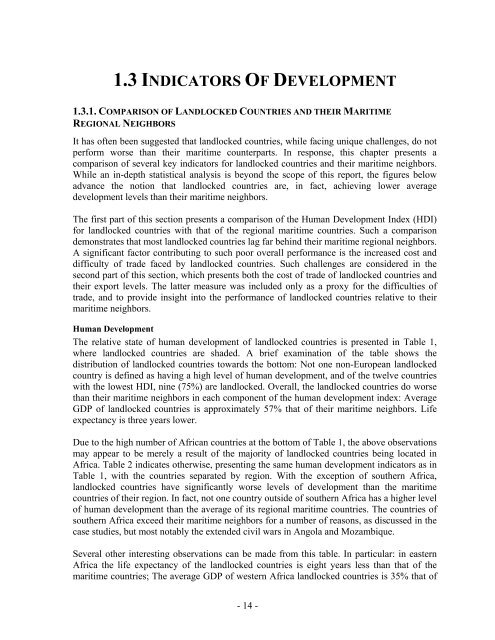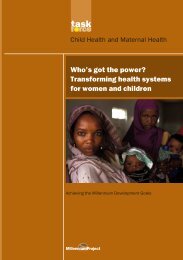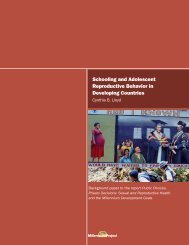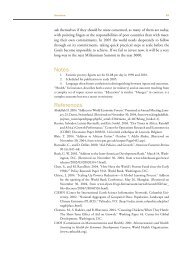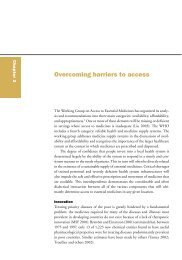the challenges facing landlocked developing countries: a case study ...
the challenges facing landlocked developing countries: a case study ...
the challenges facing landlocked developing countries: a case study ...
You also want an ePaper? Increase the reach of your titles
YUMPU automatically turns print PDFs into web optimized ePapers that Google loves.
1.3 INDICATORS OF DEVELOPMENT<br />
1.3.1. COMPARISON OF LANDLOCKED COUNTRIES AND THEIR MARITIME<br />
REGIONAL NEIGHBORS<br />
It has often been suggested that <strong>landlocked</strong> <strong>countries</strong>, while <strong>facing</strong> unique <strong>challenges</strong>, do not<br />
perform worse than <strong>the</strong>ir maritime counterparts. In response, this chapter presents a<br />
comparison of several key indicators for <strong>landlocked</strong> <strong>countries</strong> and <strong>the</strong>ir maritime neighbors.<br />
While an in-depth statistical analysis is beyond <strong>the</strong> scope of this report, <strong>the</strong> figures below<br />
advance <strong>the</strong> notion that <strong>landlocked</strong> <strong>countries</strong> are, in fact, achieving lower average<br />
development levels than <strong>the</strong>ir maritime neighbors.<br />
The first part of this section presents a comparison of <strong>the</strong> Human Development Index (HDI)<br />
for <strong>landlocked</strong> <strong>countries</strong> with that of <strong>the</strong> regional maritime <strong>countries</strong>. Such a comparison<br />
demonstrates that most <strong>landlocked</strong> <strong>countries</strong> lag far behind <strong>the</strong>ir maritime regional neighbors.<br />
A significant factor contributing to such poor overall performance is <strong>the</strong> increased cost and<br />
difficulty of trade faced by <strong>landlocked</strong> <strong>countries</strong>. Such <strong>challenges</strong> are considered in <strong>the</strong><br />
second part of this section, which presents both <strong>the</strong> cost of trade of <strong>landlocked</strong> <strong>countries</strong> and<br />
<strong>the</strong>ir export levels. The latter measure was included only as a proxy for <strong>the</strong> difficulties of<br />
trade, and to provide insight into <strong>the</strong> performance of <strong>landlocked</strong> <strong>countries</strong> relative to <strong>the</strong>ir<br />
maritime neighbors.<br />
Human Development<br />
The relative state of human development of <strong>landlocked</strong> <strong>countries</strong> is presented in Table 1,<br />
where <strong>landlocked</strong> <strong>countries</strong> are shaded. A brief examination of <strong>the</strong> table shows <strong>the</strong><br />
distribution of <strong>landlocked</strong> <strong>countries</strong> towards <strong>the</strong> bottom: Not one non-European <strong>landlocked</strong><br />
country is defined as having a high level of human development, and of <strong>the</strong> twelve <strong>countries</strong><br />
with <strong>the</strong> lowest HDI, nine (75%) are <strong>landlocked</strong>. Overall, <strong>the</strong> <strong>landlocked</strong> <strong>countries</strong> do worse<br />
than <strong>the</strong>ir maritime neighbors in each component of <strong>the</strong> human development index: Average<br />
GDP of <strong>landlocked</strong> <strong>countries</strong> is approximately 57% that of <strong>the</strong>ir maritime neighbors. Life<br />
expectancy is three years lower.<br />
Due to <strong>the</strong> high number of African <strong>countries</strong> at <strong>the</strong> bottom of Table 1, <strong>the</strong> above observations<br />
may appear to be merely a result of <strong>the</strong> majority of <strong>landlocked</strong> <strong>countries</strong> being located in<br />
Africa. Table 2 indicates o<strong>the</strong>rwise, presenting <strong>the</strong> same human development indicators as in<br />
Table 1, with <strong>the</strong> <strong>countries</strong> separated by region. With <strong>the</strong> exception of sou<strong>the</strong>rn Africa,<br />
<strong>landlocked</strong> <strong>countries</strong> have significantly worse levels of development than <strong>the</strong> maritime<br />
<strong>countries</strong> of <strong>the</strong>ir region. In fact, not one country outside of sou<strong>the</strong>rn Africa has a higher level<br />
of human development than <strong>the</strong> average of its regional maritime <strong>countries</strong>. The <strong>countries</strong> of<br />
sou<strong>the</strong>rn Africa exceed <strong>the</strong>ir maritime neighbors for a number of reasons, as discussed in <strong>the</strong><br />
<strong>case</strong> studies, but most notably <strong>the</strong> extended civil wars in Angola and Mozambique.<br />
Several o<strong>the</strong>r interesting observations can be made from this table. In particular: in eastern<br />
Africa <strong>the</strong> life expectancy of <strong>the</strong> <strong>landlocked</strong> <strong>countries</strong> is eight years less than that of <strong>the</strong><br />
maritime <strong>countries</strong>; The average GDP of western Africa <strong>landlocked</strong> <strong>countries</strong> is 35% that of<br />
- 14 -


